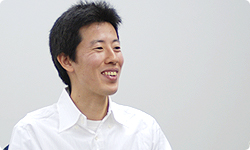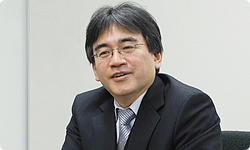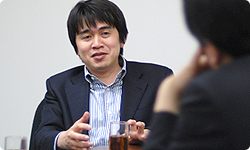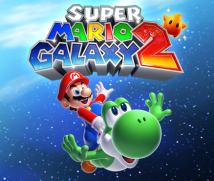4. A New Continent
You made new actions for Mario and came up with all sorts of new ideas. Why do you think you could work them out?
For generating ideas, we held regular brainstorming sessions for collecting ideas. A tremendous amount of ideas were thrown out, and Hayashida-san went over each one that looked like it might work.
The brainstorming sessions were pretty lively. No one was forced to attend the meetings, though.
Everyone was really into them.
Sometimes we came up with so many ideas that when time was up we had to force ourselves to quit.
And it wasn’t just the planners participating, but the designers and programmers as well.
When you think of designers, you tend to think of them only drawing pictures, but actually they were itching to contribute ideas.
They all want to participate in game design as well as drawing.
Yes. So when we talked to them, they had all kinds of neat ideas.
The good thing about designers is that when they have an idea, they can whip off a sketch and show it to everyone.
I’m really jealous of that skill! (laughs)
They can make the same idea look about 50% better. Inside, I’m thinking, “I had the same idea…” (laughs)
(laughs)
And this time, we prepared a tool for designers and members of the sound team to create stages themselves. That way, we hardly needed the programmers for prototypes.

So the designers were even making prototypes?
Yes. So anyone could make land forms, put in some enemies, put this and that together, and try playing it. A lot of the prototypes were made that way.
For example, there’s a stage where columns come barrelling down the road toward you . That was made by a designer who joined partway through. A prototype that was made by someone who had only joined the team one week earlier actually made its way into the game.
Of course, it went through some changes, though. Toward the end, the planners cleaned it up a bit, but for the most part they left the designer’s idea alone. Since anyone on the team could make prototypes, almost every day Hayashida-san would say, “Here, try playing this stage.”
Hayashida-san, you must have been quite happy.
Yeah! (laughs) I thought, “This is fun, but where can we put it?”
I think we repeated that process for about two and a half years.
That’s why it’s so packed with ideas. We talked about that earlier, and now I think I know one reason why that’s so.
We all worked with the concept of “more.” We delved into it “more,” and made “more” - and the result was a highly concentrated game.
When we began development, though, we didn’t think we had any ideas.
At first, you said you were all dried up! (laughs)
Yeah! (laughs) All the while we were saying we didn’t have any ideas, we were coming up with ideas! After we had hit upon the drill and Cloud Mario, I asked Miyamoto-san if we should keep making new stuff, and he said it was already overflowing with ideas, so that was enough. (laughs)
I suppose a big reason it was overflowing with ideas is because the designers and sound team were generating ideas and could try them out without relying on the programmers, but do you think there was another reason?
I think it was because we had a firm foundation in the engine from the first game. That allowed us to spend almost all of the more than two years of development coming up with ideas.
Yes, I suppose so, but I think there is another reason as well. I think a big factor is that the sphere and gravity system is only used in Mario Galaxy games. I mean, no one but you guys is trying to come up with ideas revolving around spherical landforms and gravity shifts.
Ah, I see.
It’s like a new continent with mountains of ideas. No one else has explored it, so when you do, it’s easy to discover something new. You guys came up with that stuff at an amazing rate. I think that’s one reason you came up with so many ideas.

Now that I hear you say that, I think you’re right.
Miyamoto-san said that the spheres were an incredibly interesting and appealing basis for a game and that they solved a lot of problems he had been pondering over for a long time. I think that’s why this game is so packed with ideas. Another problem you had to solve was the camera angle, right?
Yes.
Miyamoto-san said that the camera for the first Mario Galaxy reached rather high standards, but that this time it was even better. What did you do?
Last time, the spheres themselves were new, so when Mario was standing on the bottom of a planet, we tried to make it look weird and upside down. But then left and right are reversed, so I imagine some players had difficulty with the controls.
The way some people can control remote control cars and some can’t.
Exactly. So this time we made the camera angle so that wherever Mario walks on a planet, his head will, for the most part, be up and no one will have any trouble. I think that makes it much easier to play.
Miyamoto-san talked about how when you look at it from above, it looks flat.
It may be a sphere, but if you look at it from above Mario’s head, it’s a warped flat surface. And this time you can play on several stages that are flat, rather than spheres, and that also makes the camera angle easier to deal with. Miyamoto-san has always told me that when you design a stage, the camera is very important. First, you should think about how the player will view the on-screen action, and we really took that to heart this time.
Another important aspect of Mario Galaxy is that there are a variety of camera angles. Basically, someone set the camera angle for each part of the game, using this kind of angle here and having the camera stop here, and so forth. Hayashida-san’s people on the planner team went through and set several hundred different camera types by hand.
You wanted the viewpoint to feel just right, so you went through the whole game, like craftsmen, and set each individual one.
Yes. A big factor in that is that this was our second Mario Galaxy game, so we’d gained some skills and grown fairly used to such work. We have worked on 3D Mario games since Mario 6413, and I have always wondered about the wisdom of letting the players set their own camera angle.14 We made the first Mario Galaxy so that you can play it without messing with the perspective, and this time we had skilled people adjust the camera angles by hand, aiming at a 3D Mario game that could be played comfortably and would feel natural and resonate. 13Super Mario 64: The first 3D platform game in the Mario series. It was released in Europe simultaneously with the Nintendo 64 system in March 1997. 14Letting the players set their own camera angle: 3D games since Super Mario 64 have featured an element of play in which players controlled the camera angle themselves.

I see. So that’s why Miyamoto-san said the camera got much better this time. By the way, you just mentioned “resonate”. I hear you had the opportunity for a nice, long chat with Miyamoto-san.
Yes. While making this game, we went out together for the first time in a long while and talked for about four or five hours at an Indian restaurant.
